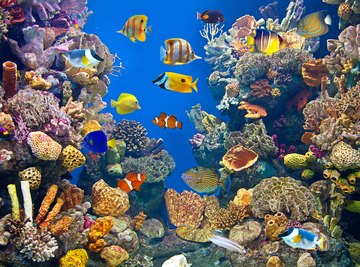
An ecosystem is a community of organisms that live and interact within a particular environment. In an aquatic ecosystem, that environment is water, and all the plants and animals in the system live either in, on or around that water. The specific setting and type of water, such as a freshwater lake or saltwater marsh, determines which animals and plants live there.
There are several different types of aquatic zones, which include marine and saltwater ecosystems as well as freshwater ecosystems like rivers, lakes and streams. Protecting these natural habitats is critical, as humans rely on aquatic ecosystems for food, recreation and fresh drinking water.
Marine or Ocean Ecosystems
Marine, or ocean, systems cover about 70 percent of the Earth’s surface and are identified by the presence of dissolved salts in the water. The level of salinity averages about 35 parts of salt per thousand parts of water in a marine ecosystem, which equals about three to four percent salt in the water.
The level of salinity can vary in response to climate or a nearby source of freshwater. Marine organisms must adapt to either a constantly changing or stable level of salt content and cannot move successfully from one to the other.
Types of Saltwater Habitats
Saltwater ecosystems range from the abundant life of coastal areas to the nearly barren ocean bottom. In marine habitats the food chain begins with plankton, microorganisms that require sunlight for energy and growth, so systems closest to the surface or in relatively shallow water support more life.
Shallow saltwater ecosystems include estuaries, salt marshes, coral reefs and other tropical habitats, and intertidal areas such as lagoons and kelp beds. Animal life in marine ecosystems ranges from microscopic zooplankton through fish of all sizes to marine mammals, including seals, whales and manatees.
Freshwater Aquatic Ecosystems
Freshwater – water that is either drinkable or has little or no salt content – supports its own aquatic ecosystems. These include rivers and streams, lakes and ponds, wetlands and even groundwater. Each of these systems is unique, and even within categories, any specific habitat is affected by altitude, temperature and humidity. For instance, a plant native to a warm shallow lake in the tropics could not survive on the steep banks of a cold, fast-moving mountain stream.
Freshwater Ecosystem Life
Freshwater ecosystems provide homes for a wide variety of animal life including insects, amphibians and fish. One estimate of fish species puts the number that live in freshwater at 40 percent of the Earth’s total. At least 45,000 fish species have been cataloged in freshwater ecosystems.
Worms, mollusks, algae and bacteria all live in freshwater systems, as do many varieties of plants. In addition, animals such as birds, otters and bears use freshwater ecosystems as a food source.
Human Impact on Aquatic Ecosystems
Human use of aquatic ecosystems also plays a role in their health and survival. Freshwater systems provide water for drinking, agricultural and industrial use, and sanitation, while marine systems provide fertilizers, food additives and cosmetics ingredients.
Both types of aquatic ecosystems provide food, transportation and recreation. However, all of this is threatened by pollution caused by agricultural and urban runoff, the introduction of exotic species to specific habitats, overfishing, coastal development and even global warming.
We can reduce our negative impact on aquatic systems by making more environmentally friendly choices in our lives. By eating sustainably-produced seafood, we can help ensure that our oceans and lakes are not overfished. Recycling plastic goods and properly disposing of waste keeps these pollutants out of our water, and using organic methods of pest control reduces runoff of pesticides.
References
About the Author
Cynthia Gast began writing professionally over 25 years ago in the automotive magazine niche and has also taught preschoolers and elementary grades. She has been a full-time freelance writer since 2008. Gast holds a Bachelor of Arts in history from the University of Illinois.
Photo Credits
Ingrid Prats/iStock/Getty Images
